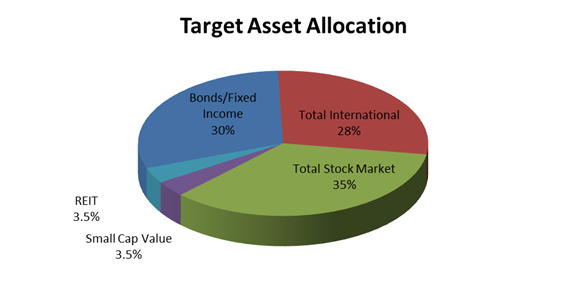Asset Allocation Update
Is it time to update your asset allocation? I just finished updating our asset allocation and rebalancing our portfolio. Let’s dig right in and see what it looks like right now.
Asset Allocation Highlights
My portfolio is built around the following asset allocation goals:
Stock/Bond Allocation: My updated stock/bond split is now 70/30. We were at 88/12 for awhile, but I’ve decided we no longer need to take that much risk.
International Allocation: 40% of Stocks (or 28% of the entire portfolio)
Tilts: REITs and Small cap value 5% of Stocks each (or 3.5% of the entire portfolio)
Bonds: Split into CDs, bond market, tips, money markets, and cash
Based on those goals, here is my current target asset allocation:
Target Asset Allocation
- Bonds/Fixed Income: 30%
- Bonds: 15%
- Tips: 15%
- Stocks: 70%
- International: 28%
- Small Cap Value: 3.5%
- REITs: 3.5%
- Total Market: 35%
Back to Basics
For those of you following my asset allocation, you’ll remember when I moved to 100% in stocks to account for the NPV of the phantom bonds we hold (the npv of pension plans and retirement plans which include a money purchase plan if higher than stock market returns). Then I worked on Adding Real Estate and Negative Bonds to our Asset Allocation to account for those investments.
What I ended up with was fantastic, and quite frankly… wouldn’t be of help to anyone. So I decided to scrap the phantom bonds from our pensions and future cash flows, negative bonds, business investments, and real estate, and share with you my asset allocation for just our standard investments.
While I do manage another degree of asset allocation that accounts for these, the feedback I received is that you just want to see what’s in our regular accounts.
More Conservative
Another thing you’ll notice is our shift to become more conservative. We’re in our 30s now, so from an age in bonds perspective, we’re in line. I’d love to tell you that’s where it came from, but it’s more based on backing into it from the crazy portfolio. We plan to move to 60/40 in the next few years.
Portfolio Makeup
Here’s a run through of the actual funds in our portfolio, which is originally based on the Total Market Approach.
International Holdings. To keep our expense ratio down I’ve elected to skip the Total International Index and build a similar holding with the EAFE index and emerging markets index (in at 85/15 split). I finally moved to the full international exposure I planned awhile back to include more international exposure. Our international holdings currently include:
- BlackRock EAFE Index Fund
- Spartan EAFE International Index Advantage (FSIVX)
- Vanguard Emerging Markets Admiral Index (VEMAX)
- Emerging Markets ETF (VWO)
Due to the recent elimination of the purchase and redemption fees on the emerging markets index, I’m hoping to consolidate the ETF and the index fund over time.
Total Stock Market. I have eliminated holdings of the S&P 500 index and the extended market funds needed to make the S&P 500 a total market holding. This is a common problem with 401k employer plans. Because the only good choice can often be a 500 index fund, you load up on that. Since I left my job, I rolled this holding over into an IRA and I no longer need to hold the extended market. All of our total stock market funds are in:
Fixed Income/Bonds. The fixed income and bond portion, which I have been adding to lately to make our portfolio more conservative, is split between bonds and tips. However, I also lump in the cash portion of our portfolio, which I keep on hand for upcoming withdrawals that I have planned. The cash is stashed in CDs at penfed, and various (low interest) money market funds, something I plan to improve on in the near future. The remaining funds are in:
- BlackRock US Bond Index Fund with a duration just over 4 years.
- Vanguard TIPS (VIPSX). I can’t hold the admiral version of this fund since it’s in a solo 401k.
Small Cap. Ugh, the small cap value tilt. Years ago, I decided to overweight small cap value. I’ve been reading everything I can about the updated research, but I’m stuck in analysis paralysis trying to decide if I should continue to overweight it. I’m curious to hear if any of you who were tilting small cap value are still doing so. We hold:
REIT. And finally, our REIT holdings (I haven’t included our actual real estate rentals in this portfolio) are in:
Our main portfolio doesn’t include any of our fun money type investments. The things I consider in that are my investment club, free money offers, like Lending club and Betterment, etc. In addition, I also exclude our kids 529 plans from our main portfolio.
Expense Ratio
The overall weighted expense ratio for our entire portfolio is now 0.114%.






Great to see that your expense ratio is so low. Too many investors ignore fees and don’t realize the impact they actually have on your returns.